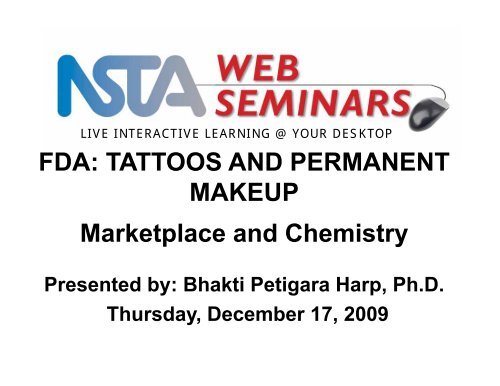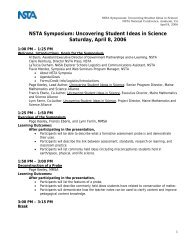FDA: TATTOOS AND PERMANENT MAKEUP Marketplace and ...
FDA: TATTOOS AND PERMANENT MAKEUP Marketplace and ...
FDA: TATTOOS AND PERMANENT MAKEUP Marketplace and ...
You also want an ePaper? Increase the reach of your titles
YUMPU automatically turns print PDFs into web optimized ePapers that Google loves.
LIVE INTERACTIVE LEARNING @ YOUR DESKTOP<br />
<strong>FDA</strong>: <strong>TATTOOS</strong> <strong>AND</strong> <strong>PERMANENT</strong><br />
<strong>MAKEUP</strong><br />
<strong>Marketplace</strong> <strong>and</strong> Chemistry<br />
Presented by: Bhakti Petigara Harp, Ph.D.<br />
Thursday, December 17, 2009<br />
1
<strong>TATTOOS</strong> <strong>AND</strong> <strong>PERMANENT</strong><br />
<strong>MAKEUP</strong><br />
<strong>Marketplace</strong> <strong>and</strong> Chemistry<br />
Bhakti Petigara Harp, Ph.D.<br />
Chemist, Color Technology Team<br />
Office of Cosmetics <strong>and</strong> Colors<br />
December 17, 2009
Modules<br />
• Regulatory status of tattoo inks <strong>and</strong><br />
pigments<br />
• <strong>Marketplace</strong><br />
– General body tattoos<br />
– Permanent makeup tattoos<br />
– Problems with tattoos <strong>and</strong> permanent makeup<br />
• Adverse reactions <strong>and</strong> <strong>FDA</strong> responses<br />
• Chemistry of tattoo pigments<br />
– Inorganic tattoo pigments<br />
– Organic tattoo pigments<br />
3
Module 1<br />
• Regulatory status<br />
4
Regulatory Definitions<br />
• Color additive – any material capable of imparting<br />
color to a food, drug, cosmetic, medical device, or the<br />
human body<br />
• Types of color additives – organic dyes <strong>and</strong><br />
pigments, inorganic pigments<br />
• Mixture – two or more color additives with or without<br />
diluents<br />
• Diluent – component of a color additive mixture added<br />
to facilitate the use of the mixture in coloring the<br />
5<br />
human body
Are tattoo pigments regulated by<br />
the <strong>FDA</strong>?<br />
Yes No<br />
6
Regulatory Status of Tattoo<br />
Pigments<br />
• Color additives must be pre-approved by <strong>FDA</strong><br />
for use in food, drugs, cosmetics, <strong>and</strong> medical<br />
devices<br />
• Approved color additives are listed in the U.S.<br />
Code of Federal Regulations<br />
– See 21 CFR Parts 73, 74, <strong>and</strong> 82<br />
• No color additives have been listed for injected<br />
use<br />
– See 21 CFR 70.5(b)<br />
7
Regulation of Tattoo Inks <strong>and</strong> Tattoo<br />
Pigments in the U.S.<br />
• Tattoo inks are cosmetics<br />
• Tattoo pigments are color additives requiring<br />
pre-market approval<br />
• <strong>FDA</strong> traditionally has not exercised its regulatory<br />
authority over tattoo inks or tattoo pigments<br />
• The practice of tattooing is regulated by local<br />
jurisdictions for sanitation<br />
• Recent adverse events have raised <strong>FDA</strong>’s<br />
concern<br />
8
Regulation of Tattooing in Other<br />
Countries<br />
• E.U. – Tattoos are “non-food products,” not<br />
cosmetics<br />
– See Opinion of Scientific Committee on Cosmetic<br />
Products <strong>and</strong> Non-Food Products, 17 February 2000<br />
– Pigments <strong>and</strong> implements are being assessed<br />
• Canada – Infection control guidelines<br />
– In partnership with provincial <strong>and</strong> territorial governments<br />
– Developed for tattoo practitioners<br />
• Australia <strong>and</strong> New Zeal<strong>and</strong> – Regulation is<br />
aimed at infection control<br />
– Oversight by individual States <strong>and</strong> Territories<br />
– Legislation does not address irritation, allergy, trauma<br />
9
Let’s Pause Two<br />
Minutes for Questions<br />
from the Audience<br />
10
•<strong>Marketplace</strong><br />
Module 2<br />
11
<strong>Marketplace</strong> – Definitions<br />
• Tattoo ink – a mixture of pigments <strong>and</strong><br />
diluents intended for introduction into the<br />
skin<br />
• Pigments – wide variety of inorganic <strong>and</strong><br />
organic compounds<br />
• Diluents – glycerin, propylene glycol,<br />
ethanol, witch hazel<br />
• Dyes – must be converted to pigments for<br />
use in tattoo inks to limit migration<br />
12
Inorganic vs. Organic Tattoo<br />
Pigments<br />
• Inorganic compounds are easily<br />
obtainable from natural sources (e.g., iron<br />
oxides)<br />
• However,<br />
– Iron oxides fade or change color<br />
– Historically used mercury <strong>and</strong> cadmium<br />
salts are toxic<br />
• Organic pigments first synthesized in mid-<br />
1800s<br />
– Satisfied need for new pigments<br />
13
Advantages of Organic Tattoo<br />
Pigments<br />
• More intense colors<br />
than inorganic<br />
pigments<br />
• Give wider range of<br />
colors<br />
•Are removable with<br />
laser techniques<br />
14
<strong>Marketplace</strong> – Inks <strong>and</strong><br />
implements<br />
15
What percentage of people have<br />
Multiple Choice<br />
A. 10%<br />
B. 40%<br />
C. 90%<br />
tattoos?<br />
17
General Body Tattooing<br />
18
Fluorescent Tattoo Inks<br />
21
• General body<br />
tattoo inks<br />
• Tattoo parlors<br />
historically<br />
avoided the<br />
face<br />
_______________<br />
__<br />
• Permanent<br />
cosmetics inks<br />
(face/eyes)<br />
22
Permanent Makeup<br />
• Before <strong>and</strong> after<br />
photos (Premier<br />
Pigments web site)<br />
• Eyeliner<br />
• Eyebrows<br />
• Lipliner<br />
• Full lips<br />
• Blusher<br />
• Also called<br />
micropigmentation<br />
23
Examples of Permanent Makeup<br />
EYELINER EYEBROWS<br />
MOLE<br />
24
Permanent Makeup Tattoo Machine<br />
25
Problems with Tattoos<br />
<strong>and</strong> Permanent Makeup<br />
• Safety for skin injection has not been<br />
demonstrated<br />
• Adverse reactions have occurred<br />
• Photosensitivity is a problem<br />
• Removal is a problem<br />
27
Problems with Tattoo/Permanent<br />
Makeup Industry<br />
• Technicians diverse: amateurs to MDs/RNs<br />
• Non-medical technicians have little training in<br />
sterile techniques<br />
• Medical personnel may have limited expertise<br />
in makeup application<br />
• Beauty salons/tattoo parlors regulated by<br />
State <strong>and</strong> local Health Departments<br />
28
Permanent<br />
Makeup in<br />
Medical Setting<br />
• Injected anesthesia<br />
• Clamp secures eyelid<br />
• Calipers ensure<br />
placement<br />
• Varying artistic ability<br />
29
Tattoos/Permanent Makeup<br />
in Salon, Home, Workshop Settings<br />
• No injected<br />
anesthesia<br />
• Varying<br />
sterile<br />
techniques<br />
30
Let’s Pause Two<br />
Minutes for Questions<br />
from the Audience<br />
31
Module 3<br />
• Adverse Reactions<br />
32
Adverse Reactions to Tattoos<br />
<strong>and</strong> Permanent Makeup<br />
• Swelling, cracking, peeling, blistering,<br />
scarring<br />
• Granulomas (small nodules of inflamed skin)<br />
• Keloids (scars that grow beyond normal<br />
boundaries)<br />
• Serious disfigurement<br />
• MRI complications<br />
33
Adverse Reactions – Granulomas<br />
34
Adverse Reactions in Sunlight<br />
35
Adverse Reactions to Surgical<br />
• Laser removal<br />
– Painful<br />
– Expensive<br />
– Usually leaves<br />
scarring<br />
– Iron oxide <strong>and</strong><br />
titanium dioxide<br />
pigments turn<br />
black<br />
Removal<br />
36
Adverse Reactions to Permanent<br />
Makeup<br />
• 1988 to 2003 – <strong>FDA</strong> received only five reports of adverse<br />
reactions<br />
• 2003 to 2004 – <strong>FDA</strong> received more than 150 reports of adverse<br />
reactions<br />
• <strong>FDA</strong> <strong>and</strong> CDC – identified 101 patients with adverse reactions<br />
• Adverse reactions – tenderness, swelling, itching, <strong>and</strong> bumps<br />
• Clinical diagnoses – allergic or granulomatous reactions<br />
37
Adverse Reactions to Permanent<br />
Makeup<br />
38
<strong>FDA</strong> <strong>and</strong> CDC Actions<br />
• July 2 2004 – <strong>FDA</strong> alerted public to concerns with Premier<br />
Pigment br<strong>and</strong> of ink shades<br />
– “<strong>FDA</strong> Talk Paper” (press release)<br />
– Web site (archived)<br />
• Sept 27 2004 – Product line recalled by manufacturer<br />
• July 2005 – Case study in Archives of Dermatology<br />
• June 28 2007 – Letter to New Engl<strong>and</strong> Journal of Medicine<br />
• Current web site “Tattoos <strong>and</strong> Permanent Makeup”<br />
http://vm.cfsan.fda.gov/~dms/cos-204.html<br />
39
Adverse Reactions to<br />
Tattoo Inks Without Preservatives<br />
• “The ingredients of “… “ UV Tattoo Inks: (PMMA)<br />
Polymethylmethacrylate 97.5% <strong>and</strong> microspheres of<br />
fluorescent dye 2.5% suspended in UV sterilized,<br />
distilled water with no preservatives or other additives.”<br />
• “TATTOOISTS REMEMBER - these black light tattoo<br />
inks are made with sterilized distilled waters, do not add<br />
foreign objects into your ink bottles!. This is not an<br />
alcohol based tattoo ink.”<br />
40
<strong>FDA</strong> Action – Starbrite Ink<br />
Contamination<br />
• (2004) Belgium withdrew “Starbrite Colors” tattoo ink from<br />
market because of microbial contamination<br />
• <strong>FDA</strong> analyses found bacteria (Pseudomonas aeruginosa)<br />
<strong>and</strong> mold (Acremonium)<br />
• Resulted in manufacturer recall of Starbrite ink (Class II,<br />
reversible injury)<br />
• Starbrite ink became contaminated because the<br />
manufacturer removed alcohol preservative from their<br />
ink formula<br />
41
Problems with Tattoo Ink:<br />
Claiming <strong>FDA</strong> Approval on Web Sites<br />
• Polymethylmethacrylate in tattoo inks:<br />
“We researched scientific articles on bone repair,<br />
plastic surgery, orthodontics, body modification, <strong>and</strong><br />
other medical uses of polymethylmethacrylate<br />
(PMMA). The PMMA is what makes this ink absolutely<br />
safe, <strong>and</strong> gives this ink its <strong>FDA</strong> Approval.”<br />
• On “Chameleon Body Art Supply” web site:<br />
http://www.crazychameleonbodyartsupply.com/bmx-<br />
1000-chameleon-tattoo-inks.htm<br />
43
Problems with Tattoo Ink:<br />
Citing <strong>FDA</strong> Approval for Tattooing Fish<br />
• <strong>FDA</strong> letter dated April 3, 1995:<br />
“Having reviewed the information supplied by you<br />
[our manufacturer of the ink] <strong>and</strong> your supplier ...<br />
<strong>FDA</strong> would have no objection to the use of your<br />
photonic dye marking [tattooing] system ...”<br />
• On “Captain Jack’s Tattoo Studio” web site:<br />
http://www.captainjackstattoo.com/content/blacklig<br />
ht-inks<br />
44
Temporary Tattoos – Decals<br />
• Temporary tattoos are regulated as cosmetics<br />
• Declaration of ingredients is required<br />
• Approved color additives are required<br />
• Import alert – for temporary tattoos containing<br />
non-permitted (illegal) color additives<br />
• http://www.fda.gov/Cosmetics/Product<strong>and</strong>Ingredi<br />
entSafety/ProductInformation/ucm108569.htm<br />
45
Body Decoration with Henna<br />
46
Is henna approved for<br />
use on the skin?<br />
Yes No<br />
47
Henna Tattoos <strong>and</strong> Body Decoration<br />
(Mehndi)<br />
• Henna is derived from the leaves of the shrub<br />
Lawsonia inermis<br />
– Brown, orange-brown, or reddish-brown tints<br />
• Approved color additive for coloring hair<br />
– See 21 CFR 73.2190<br />
• Coloring the skin is an unapproved use of the color<br />
additive<br />
• Import alert – for “Henna based skin color” products<br />
48
Body Decoration with Black<br />
Henna<br />
49
Adverse Reactions to Black Henna<br />
• “Black henna” contains additional coloring ingredients<br />
– Allows darker, more intense color<br />
– Speeds up tattooing process, makes tattoo last<br />
longer<br />
• p-Phenylenediamine (PPD) may be added<br />
– A hair dye<br />
– Not approved for direct application to the skin<br />
• Allergic reactions to PPD<br />
– Potent skin sensitizer, possibly for lifetime<br />
– Allergic contact dermatitis<br />
– Cross-reactions to PABA, benzocaine, indigo<br />
50<br />
• Feb 13 2007 Article in Canadian Medical Assn Journal
Let’s Pause Two<br />
Minutes for Questions<br />
from the Audience<br />
51
Module 4<br />
• Chemistry of Tattoo Pigments<br />
52
Chemistry of Tattoo Pigments<br />
• Basic concept of color<br />
• Inorganic pigments<br />
• Organic pigments<br />
– Insoluble organic compounds<br />
– Dyes converted to insoluble pigments<br />
• None are <strong>FDA</strong> approved for use in<br />
injections (tattoos)<br />
53
Why not use FD&C colors in<br />
tattoos?<br />
Type in the chat<br />
54
Electromagnetic spectrum<br />
www.owlnet.rice.edu/~psyc351/Images/Electroma<br />
55
Basic Concepts of Color<br />
• Interaction of visible light with a compound<br />
– Wavelengths of light<br />
– Types of atoms in the compound<br />
• Dye molecules contain electrons at many<br />
energy levels<br />
– Some of the electrons can absorb visible light<br />
– These electrons undergo transitions from<br />
lower to higher energy levels<br />
• Absorption removes some visible light<br />
– We see the complementary color<br />
56
Production of complementary<br />
25.198 Peak 20<br />
236.9<br />
316.1<br />
nm<br />
493.8<br />
colors<br />
660.7<br />
300.00 400.00 500.00 600.00 700.00<br />
D&C Red<br />
No. 6<br />
Absorption<br />
b<strong>and</strong>s<br />
• 400-430 nm (violet) see yellow<br />
• 430-480 nm (blue)<br />
orange<br />
see<br />
• 480-550 nm (green) see red<br />
• 550-600 nm (yellow) see violet<br />
• 600-700 nm (red) see blue<br />
25.722 Peak 10<br />
306.6 406.8<br />
nm<br />
630.2<br />
719.5 790.5<br />
200.00 300.00 400.00 500.00 600.00 700.00 800.00<br />
FD&C Blue No. 1<br />
57
25.722 Peak 10<br />
What color would you see?<br />
306.6 406.8<br />
nm<br />
630.2<br />
Absorptions b<strong>and</strong>s:<br />
719.5 790.5<br />
200.00 300.00 400.00 500.00 600.00 700.00 800.00<br />
• 400-430 nm (violet) see yellow<br />
• 430-480 nm (blue) see orange<br />
• 480-550 nm (green) see red<br />
• 550-600 nm (yellow) see violet<br />
• 600-700 nm (red) see blue<br />
Multiple Choice<br />
A. Red<br />
B. Yellow<br />
C. Blue<br />
58
Absorptivity value<br />
• Measure of dye’s ability to absorb light<br />
• High absorptivity value: more efficient, more economical<br />
– Dye absorbs a large amount of energy so you only need a<br />
small amount in the product<br />
• Low absorptivity value: not as efficient, less economical<br />
– Dye absorbs less energy so more is needed in the<br />
product<br />
A<br />
1.08<br />
1.0<br />
0.9<br />
0.8<br />
0.7<br />
0.6<br />
0.5<br />
0.4<br />
0.3<br />
0.2<br />
0.1<br />
408.42<br />
629.56<br />
0.00<br />
400.0 500 600<br />
NM<br />
700 750.0<br />
FD&C Blue No. 1, α =<br />
0.16<br />
A<br />
1.00<br />
0.9<br />
0.8<br />
0.7<br />
0.6<br />
0.5<br />
0.4<br />
0.3<br />
0.2<br />
0.1<br />
0.00<br />
644.94<br />
400.0 500 600 700 750.0<br />
nm<br />
D&C Green No. 5, α = 0.02<br />
59
Early food <strong>and</strong> cosmetic uses<br />
of dyes <strong>and</strong> pigments<br />
• Foods colored with spices <strong>and</strong> minerals<br />
– Paprika, turmeric, saffron, iron oxides<br />
– Wine artificially colored in 300 B.C.<br />
• Cosmetics from vegetable <strong>and</strong> mineral<br />
sources<br />
– White lead<br />
– Kohl (contains lead or antimony)<br />
– Copper ore for eye shadow<br />
– Vegetable extracts for the skin<br />
• Tattooing<br />
– Charcoal, inorganic pigments<br />
60
Historically Used Tattoo Pigments<br />
• Black – iron oxide, carbon<br />
• Red – mercury sulfide, iron oxide<br />
• Yellow – cadmium sulfide, iron oxide<br />
• Blue – cobaltous aluminate, ferric ferrocyanide<br />
• Green – chromium oxide, chromium hydroxide<br />
• White – titanium dioxide<br />
61
Historically Used Minerals in Tattoo<br />
Pigments<br />
• Black<br />
– Magnetite<br />
(FeO•Fe2O3)<br />
– Charcoal (C)<br />
• Red<br />
– Hematite (Fe2O3)<br />
– Cinnabar (HgS)<br />
• Yellow<br />
– Limonite<br />
(FeO•OH•nH2O)<br />
• White<br />
– Corundum (Al2O3)<br />
– Rutile (TiO2)<br />
– Zincite (ZnO)<br />
62
<strong>FDA</strong> Analyses of Inorganic Pigments in<br />
Tattoo/Permanent Makeup Inks<br />
• Samples of sixty-three tattoo/permanent<br />
makeup inks from three different manufacturers<br />
• Analyzed by x-ray fluorescence spectrometry<br />
• Results found Ti, Al, <strong>and</strong> Fe to be most<br />
common<br />
• Historically reported Hg, Cd, Co, <strong>and</strong> Ni were<br />
not found<br />
63
Inorganic Elements Found in Tattoo<br />
Pigments<br />
• Black – Fe<br />
• Gray – Fe, Ti, Al<br />
• Brown – Fe, Ti, Al, Ca<br />
• Blue – Ti, Al, Cu<br />
• Green – Fe, Ti, Al, Ba, Br, Cr, Cu<br />
• Red <strong>and</strong> Magenta – Ti, Al, Fe<br />
• Orange – Ti, Fe, Al<br />
• Yellow – Ti, Fe, Al<br />
• White – Ti, Al<br />
64
<strong>FDA</strong> Analyses of Organic Pigments in<br />
Tattoo/Permanent Makeup Inks<br />
• Samples of thirty-five tattoo/permanent makeup inks<br />
analyzed from four different manufacturers<br />
• Compounds in inks extracted <strong>and</strong> separated by<br />
HPLC<br />
• Organic pigments identified by comparison of UVvisible<br />
spectra <strong>and</strong> HPLC retention times with<br />
reference st<strong>and</strong>ards<br />
• Results showed mixtures of organic pigments from<br />
different chemical classes<br />
65
Organic Pigments in Tattoo/Permanent<br />
Makeup Inks<br />
Chemical<br />
Class Benzimidazolones Monoazo Naphthol<br />
Quinacridone<br />
Sample<br />
Pigment<br />
Brown 25<br />
Pigment<br />
Orange<br />
36<br />
Pigment<br />
Orange<br />
62<br />
Pigment<br />
Red<br />
170<br />
Pigment<br />
Red<br />
22<br />
Pigment<br />
Red 122<br />
Monoazo<br />
Arylide<br />
Pigment<br />
Yellow 74<br />
1 x x<br />
2<br />
x<br />
3 x x x<br />
4 x x<br />
5 x x<br />
6 x x<br />
7 x x x<br />
8 x x x<br />
9<br />
x<br />
10 x x<br />
11 x<br />
12<br />
13<br />
x x<br />
14 x<br />
15 x<br />
16 x<br />
17 x<br />
18 x<br />
19 x<br />
20 x x<br />
21 x x<br />
22 x x<br />
23 x x<br />
24 x x<br />
25 x x<br />
26 x<br />
27 x<br />
28<br />
29<br />
x x<br />
30 x<br />
31 x<br />
32 x<br />
33<br />
34<br />
35<br />
x<br />
**Other unidentified peaks were found<br />
66
Organic Tattoo Pigments – Dye<br />
• Anthraquinone<br />
O<br />
O<br />
R 1<br />
R 2<br />
• Azo, Disazo<br />
• Benzimidazolone<br />
H<br />
N<br />
N<br />
H<br />
O<br />
Structures<br />
• Indigoid<br />
X<br />
O<br />
O<br />
X<br />
• Phthalocyanine<br />
•<br />
Quinacridon<br />
e<br />
67
C.I. Pigment Red 83<br />
• C.I. 58000<br />
• CAS No. 72-48-0<br />
• Alizarin Red<br />
• Anthraquinone dye<br />
• 1,2-Dihydroxy-9,10anthracenedione<br />
68
H 3C<br />
O<br />
O OH<br />
NH<br />
C.I. Pigment Red 170<br />
N<br />
N<br />
NH 2<br />
O<br />
• C.I. 12475<br />
• CAS No. 2786-76-7<br />
• Fast Red F5RK<br />
• Monoazo dye<br />
• 4-((4-(Aminocarbonyl)<br />
phenyl)azo)-N-(2ethoxyphenyl)-3-hydroxy-2naphthalenecarboxamide<br />
69
O<br />
O<br />
C.I. Pigment Orange 16<br />
NH CH3 H3C O<br />
N<br />
N<br />
N N<br />
CH3 O<br />
O<br />
H3C O<br />
NH<br />
• C.I. 21160<br />
• CAS No. 6505-28-8<br />
• Dianisidine Orange or<br />
Benzidine Orange R<br />
• Disazo dye<br />
• 2,2'-((3,3'-dimethoxy<br />
(1,1'-biphenyl)-4,4'diyl)bis(azo))bis(3-oxo-Nphenyl-butanamide)<br />
70
C.I. Pigment Yellow 151<br />
• C.I. 13980<br />
• CAS No. 31837-42-0<br />
• Fast Yellow H4G<br />
• Benzimidazolone <strong>and</strong><br />
monoazo dye<br />
• 2-[[1-[[(2,3-Dihydro-2oxo-1H-benzimidazol-5yl)amino]carbonyl]-2oxopropyl]azo]benzoic<br />
acid<br />
71
HN<br />
O<br />
NH<br />
O<br />
NH<br />
OH<br />
C.I. Pigment Violet 32<br />
H 3C<br />
N<br />
N<br />
O<br />
CH 3<br />
O<br />
O<br />
S<br />
N<br />
O H<br />
CH 3<br />
• C.I. 12517<br />
• CAS No. 12225-08-0<br />
• Brillfast Vivid Magenta<br />
• Benzimidazolone <strong>and</strong><br />
monoazo dye<br />
• N-(2,3-dihydro-2-oxo-1Hbenzimidazol-5-yl)-4-<br />
[[2,5-dimethoxy-4-<br />
[((methylamino)-sulfonyl]phenyl]-azo]-3-hydroxy-2naphthalenecarboxamide<br />
72
C.I. Pigment Blue 66<br />
• C.I. 73000<br />
• C.I. Vat Blue 1<br />
• CAS No. 482-89-3<br />
• Indigo<br />
• Indigoid dye<br />
• 2-(1,3-Dihydro-3-oxo-2Hindol-2-ylidene)-1,2dihydro-3H-indol-3-one<br />
73
C.I. Pigment Blue 15<br />
N N<br />
N<br />
Cu<br />
N<br />
• C.I. 74160<br />
• CAS No. 147-14-8<br />
• Copper phthalocyanine<br />
• Cyan Blue GTNF or<br />
Heliogen Blue 7044T<br />
• Phthalocyanine dye<br />
• Copper, (29H,31Hphthalocyaninato(2-)-<br />
N29,N30,N31,N32)-<br />
74
C.I. Pigment Red 122<br />
• C.I. 73915<br />
• CAS No. 980-26-7<br />
• Acramin Scarlet LDCN or<br />
Fastogen Super Magenta<br />
R<br />
• Quinacridone dye<br />
• 5,12-Dihydro-2,9dimethylquino(2,3b)acridine-7,14-dione<br />
75
Tattoo Pigment Photodecomposition<br />
Studies<br />
• <strong>FDA</strong>’s National Center for Toxicological<br />
Research (NCTR)<br />
• Cui, Y., Spann, A. P., Couch, L. H., Gopee,<br />
N. V., Evans, F. E., Churchwell, M. I.,<br />
Williams, L. D., Doerge, D. R., <strong>and</strong> Howard,<br />
P.C., “Photodecomposition of Pigment<br />
Yellow 74, a Pigment Used in Tattoo Inks,<br />
Photochemistry <strong>and</strong> Photobiology, vol. 80,<br />
pp. 175 -184, 2004<br />
76
O<br />
Photodecomposition of Pigment Yellow 74<br />
in simulated solar light<br />
O<br />
N<br />
O<br />
N<br />
O<br />
O CH 3<br />
O CH 3<br />
NH 2<br />
NH N<br />
O CH 3<br />
O<br />
H 3C<br />
NH<br />
O CH 3<br />
O<br />
H 3C<br />
NH<br />
O<br />
HO<br />
O<br />
O CH 3<br />
N<br />
O<br />
H 3C<br />
NH<br />
O<br />
77
Photodecomposition of Pigment Red 22<br />
in 532 nm Nd:YAG laser light<br />
O<br />
N<br />
O<br />
O<br />
N<br />
O<br />
CH 3<br />
NH 2<br />
O<br />
N<br />
O<br />
CH 3<br />
N N<br />
O<br />
HO NH<br />
CH 3<br />
O<br />
HO NH<br />
78
Tattoo Pigments <strong>and</strong> Color<br />
Additives<br />
NaO 3S<br />
N<br />
H<br />
O<br />
O<br />
H<br />
N<br />
SO 3Na<br />
Indigo (tattoo pigment) 21 CFR 74.101<br />
<strong>and</strong> FD&C Blue No. 2<br />
21 CFR 74.3106<br />
drugs,<br />
(for use in food,<br />
D&C Blue No. 6<br />
sutures,<br />
cosmetics,<br />
(for use in sutures only)<br />
cement)<br />
<strong>and</strong> bone<br />
79
Tattoo Pigments <strong>and</strong> Color<br />
N N<br />
N<br />
Cu<br />
N<br />
Additives<br />
• C.I. Pigment Blue 15<br />
• Copper<br />
phthalocyanine<br />
• 21 CFR 74. 3045<br />
[Phthalocyaninato(2-)]<br />
copper (for use in<br />
sutures only)<br />
80
Tattoo Pigments <strong>and</strong> Color<br />
• Aluminum oxide<br />
– 21 CFR 73.1010<br />
• Carmine<br />
– 21 CFR 73.100<br />
– 21 CFR 73.1100<br />
• Iron oxides<br />
– 21 CFR 73.2250<br />
– 21 CFR 73.3125<br />
• Manganese violet<br />
– 21 CFR 73.2775<br />
• Mica<br />
– 21 CFR 73.1496<br />
– 21 CFR 73.2496<br />
Additives<br />
• Titanium dioxide<br />
– 21 CFR 73.575<br />
– 21 CFR 73.1575<br />
– 21 CFR 73.2575<br />
– 21 CFR 73.3126<br />
• Ultramarines<br />
– 21 CFR 73.50<br />
– 21 CFR 73.2725<br />
• Zinc oxide<br />
– 21 CFR 73.1991<br />
– 21 CFR 73.2991<br />
• Luminescent zinc oxide<br />
– 21 CFR 73.2995<br />
81
Conclusions<br />
• <strong>Marketplace</strong> – Wide variety of inorganic <strong>and</strong> organic<br />
pigments <strong>and</strong> diluents in tattoos <strong>and</strong> permanent<br />
makeup<br />
• Adverse reactions – <strong>and</strong> <strong>FDA</strong> responses<br />
• Chemistry – Some tattoo pigments have been shown<br />
to photodecompose<br />
– C.I. Pigment Yellow 74<br />
– C.I. Pigment Red 22<br />
• Misleading web sites!!! No pigments have been<br />
approved by <strong>FDA</strong> for tattooing humans<br />
82
Thank you to the sponsor of<br />
tonight's Web Seminar:
http://learningcenter.nsta.org<br />
84
http://www.elluminate.com<br />
85
National Science Teachers Association<br />
Dr. Francis Q. Eberle, Executive Director<br />
Zipporah Miller, Associate Executive Director<br />
Conferences <strong>and</strong> Programs<br />
Al Byers, Assistant Executive Director e-Learning<br />
NSTA Web Seminars<br />
Paul Tingler, Director<br />
Jeff Layman, Technical Coordinator<br />
LIVE INTERACTIVE LEARNING @ YOUR DESKTOP<br />
86







